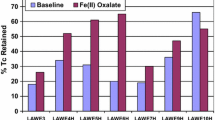Abstract
THE future of nuclear power is often said to depend on the development of a satisfactory method for dealing with highly radioactive waste such as the liquid which is produced during the extraction of plutonium from irradiated nuclear fuel. (See recommendation 27 in ref. 1). Much attention is now being given to developing processes suitable for solidifying highly active liquid waste2 and conversion to a borosilicate glass seems the most favourable route. Here we report a recent investigation at Harwell which supports the belief that the installation of a satisfactory full-scale vitrification process will be successfully achieved.
Similar content being viewed by others
References
Royal Commission on Environmental Pollution, 6th Rep. (HMSO Cmnd 6618, London, 1976).
Symp. on Management of Radioactive Wastes from the Nuclear Fuel Cycle (IAEA and NEA (OECD), Vienna 1976).
Grover, J. R., Hardwick, W. H., Gayler, R. & Delve, M. H. The FINGAL Process (Conf–660208 (USAEC), Richland, 1966).
Author information
Authors and Affiliations
Rights and permissions
About this article
Cite this article
MORRIS, J., BOULT, K., DALTON, J. et al. Durability of vitrified highly active waste from nuclear reprocessing. Nature 273, 215–216 (1978). https://doi.org/10.1038/273215a0
Received:
Accepted:
Issue Date:
DOI: https://doi.org/10.1038/273215a0
- Springer Nature Limited





